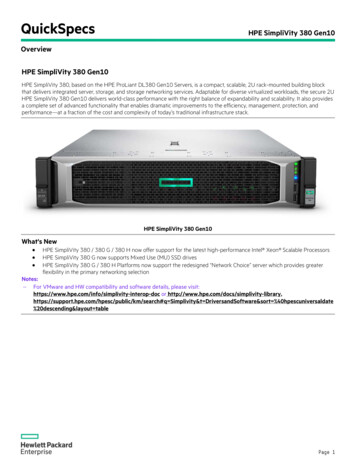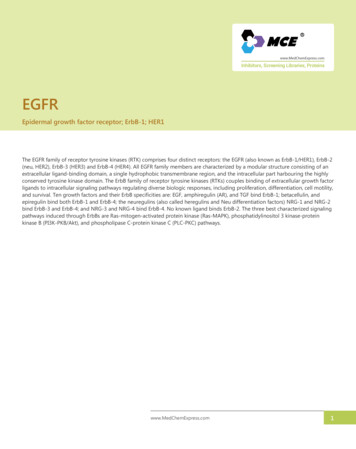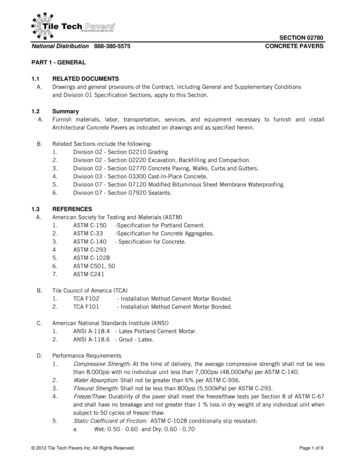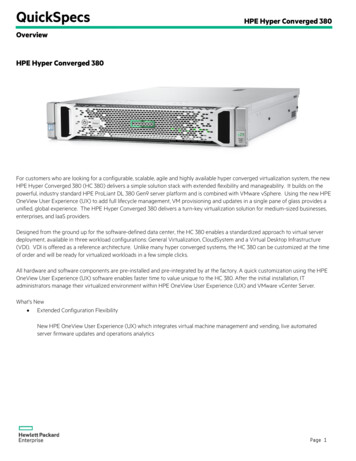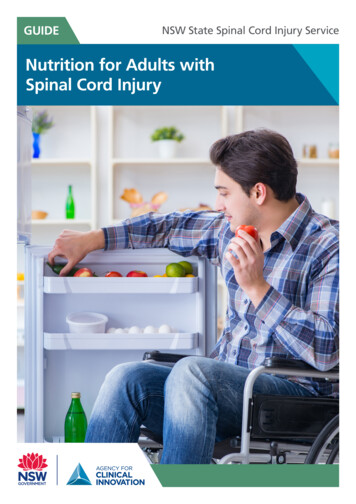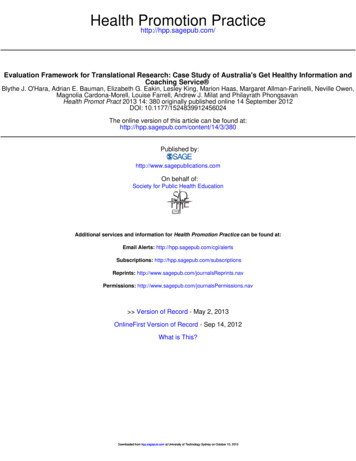
Transcription
Health PromotionPracticehttp://hpp.sagepub.com/Evaluation Framework for Translational Research: Case Study of Australia's Get Healthy Information andCoaching Service Blythe J. O'Hara, Adrian E. Bauman, Elizabeth G. Eakin, Lesley King, Marion Haas, Margaret Allman-Farinelli, Neville Owen,Magnolia Cardona-Morell, Louise Farrell, Andrew J. Milat and Philayrath PhongsavanHealth Promot Pract 2013 14: 380 originally published online 14 September 2012DOI: 10.1177/1524839912456024The online version of this article can be found d by:http://www.sagepublications.comOn behalf of:Society for Public Health EducationAdditional services and information for Health Promotion Practice can be found at:Email Alerts: http://hpp.sagepub.com/cgi/alertsSubscriptions: http://hpp.sagepub.com/subscriptionsReprints: ions: http://www.sagepub.com/journalsPermissions.nav Version of Record - May 2, 2013OnlineFirst Version of Record - Sep 14, 2012What is This?Downloaded from hpp.sagepub.com at University of Technology Sydney on October 10, 2013
456024HPPXXX10.1177/1524839912456024HEALTH PROMOTION PRACTICE / Month XXXXO’Hara et al. / EVALUATION FRAMEWORKFOR TRANSLATIONAL RESEARCH2012Evaluation Framework for TranslationalResearch: Case Study of Australia’s GetHealthy Information and Coaching Service Blythe J. O’Hara, MAppSc1Adrian E. Bauman, PhD1Elizabeth G. Eakin, PhD2Lesley King, MPsych1Marion Haas, PhD3Margaret Allman-Farinelli, PhD1Neville Owen, PhD4Magnolia Cardona-Morell, PhD1Louise Farrell, MPH5Andrew J. Milat, MPH (Hons)5Philayrath Phongsavan, PhD1The Get Healthy Information and Coaching Service (GHS), a free government-funded telephone-deliveredinformation and coaching service was launched inFebruary 2009 by the Australian New South Walesstate government. It represents the translation ofresearch evidence applied in the real world (T4 orPhase 4 translation), aimed at addressing the modifiable risk factors associated with the overweight andobesity. In controlled settings, it has been establishedthat telephone-based lifestyle counseling programs areefficacious in reducing anthropometric and behavioralrisk factors. This article presents the GHS case study asa population-wide intervention and describes thequasi-experimental evaluation framework used to evaluate both the process (statewide implementation) andimpact (effectiveness) of the GHS in a real-world environment. It details the data collection, measures, andstatistical analysis required in assessing the process ofimplementation—reach and recruitment, marketingand promotion, service satisfaction, intervention fidelity, and GHS setting up and operations costs—and inassessing the impact of GHS—increasing physicalactivity, improving dietary practices, and reducingHealth Promotion PracticeMay 2013 Vol. 14, No. 3 380 –389DOI: 10.1177/1524839912456024 2012 Society for Public Health Education380body weight and waist circumference. The comprehensive evaluation framework designed for the GHS provides a method for building effectiveness evidence of arare translation of efficacy trial evidence into populationwide practice.Keywords:evaluation design; behavior change; obesityINTRODUCTION The prevalence of overweight and obesity continuesto increase across the world, and Australia is no exception,1University of Sydney, Sydney, New South Wales, AustraliaUniversity of Queensland, Brisbane, Queensland, Australia3University of Technology, Sydney, New South Wales, Australia4Baker IDI, Heart and Diabetes Institute, Melbourne, Victoria,Australia5NSW Ministry of Health, Sydney, New South Wales, Australia2Authors' Note: The NSW Ministry of Health provided funding tothe University of Sydney to undertake an independent, comprehensive evaluation of the Get Healthy Service. No individualauthor received financial support. Please address correspondenceto Blythe O’Hara, Prevention Research Collaboration, SydneySchool of Public Health, Medical Foundation Building K25,University of Sydney, Sydney, New South Wales 2006, Australia;e-mail: blythe.ohara@sydney.edu.au.
as nearly two thirds of the adult population are overweight or obese (Australian Bureau of Statistics, 2009),with associated direct and indirect costs in the order of 21 billion (Colagiuri, Lee, et al., 2010). The causes aremodifiable behavioral risk factors, such as increasedconsumption of energy-dense and nutritionally poorfoods and inadequate levels of physical activity (Popkin& Gordon-Larsen, 2004). To reverse the trends of inadequate levels of physical activity, poor nutrition, andincreasing overweight and obesity, the populationhealth importance of providing mass reach, evidencebased lifestyle improvement programs that are effective, relevant, accessible, and equitable is a publichealth priority.The Australian Get Healthy Information and CoachingService (GHS), a free telephone-based information andcoaching service, was launched in February 2009 tosupport individuals make lifestyle-based changes. As agovernment-funded service, GHS was introduced amidgrowing evidence for efficacious, mediated (i.e., notface-to-face) behavior-based interventions to addresschronic disease risk behaviors such as physical inactivity, unhealthy eating, and overweight and obesity. Theevidence base from systematic reviews has confirmedthat telephone-based interventions (Eakin, Lawler,Vandelanotte, & Owen, 2007; Goode, Reeves, & Eakin,2012) are effective in increasing physical activity,improving nutrition, and reducing weight in the shortto medium term (3-6 months) across different populations, in a range of settings, and using different intervention modalities (Eakin et al., 2007).However, published reports demonstrating the translation of this research into population-wide programsare limited. Whereas translational research from trials(Lindström et al., 2006) in other chronic disease domainssuch as diabetes is being championed in the primaryhealth care setting for those with diabetes (Colagiuri,Vita, et al., 2010), lifestyle-based interventions and theireffectiveness for addressing chronic disease risk factorsand overweight and obesity in the general adult population remain largely untested and require further exploration, and the processes of translating researchevidence to population-wide practice and policy needto be better understood (Goode et al., 2012; Jepson,Harris, Platt, & Tannahill, 2010).The importance of translational research is gainingprominence, with varying definitions of what translational research entails. One perspective describestranslational research as technical linear processes (T1,basic scientific discovery; T2, evaluation of efficacy;T3, uptake and implementation into practice; and T4,focusing on evaluating the population-level healthimpact of interventions; Khoury, Gwinn, & Ioannidis,2010). Another considers this research area as iterativeapproaches that triangulate research, evidence, andpolicy and practice (Glasgow, Green, Taylor, & Stange,2012). A recent work on this area conceptualizes translational research as multilayered, staged models thatemphasize not only the translation of research but alsothe importance of translating knowledge into evidencebased practice and vice versa (Rychetnik et al., 2012).Moreover, this perspective stresses researching andevaluating how and in what conditions evidence ofintervention effectiveness in one setting can be translated to new settings and populations and to a largerscale. The goal is that a program has community-widereach among the populations for whom it is intended.Regardless of the model, translation research articulates the significance of moving beyond the controlledsettings afforded to traditional research trials to the realworld and all the complexities it involves.The GHS provides a rare example of a T4 translational research (Khoury et al., 2010; Rychetnik et al.,2012). Incumbent in the implementation of a programsuch as GHS is the responsibility to establish an evaluation framework that focuses on evaluating the replicationand dissemination of efficacious trials and translatingthis knowledge into ongoing practice (Rychetnik et al.,2012). The characteristics of and the delivery of the GHStailored to the needs of each individual, as describedbelow, challenge the adequacy of the commonly usedexperimental evaluation designs, such as randomizedcontrolled trials or group randomized controlled trialswhere communities, schools, or worksites can be randomly allocated. Other evaluation designs are oftenrequired for evaluating large-scale programs because ofethical or practical limitations preventing randomization. The tailored, self-directed, multicomponent elements of the GHS also preclude the intervention beingdelivered in a tightly controlled environment, with itsimpact likely to be influenced by external factors. Inthese situations, quasi-experimental or pretest andposttest evaluation designs may be all that is possible.This presents a constant tension between scientificrigor of evaluation and recognition of the delivery of aservice that is highly context dependent.Therefore, a comprehensive translatable evaluationframework that gives a balanced emphasis on assessingthe implementation process and the effectiveness ofGHS is required. The stages of research and evaluationmodel originally developed by Bauman and Nutbeam(2006) and further developed by Rychetnik et al. (2012)is used to guide portfolio development of evaluationsubstudies for the GHS. This model conceptualizesevaluation in several phases, from testing a new intervention in controlled conditions, evaluating efficaciousO’Hara et al. / EVALUATION FRAMEWORK FOR TRANSLATIONAL RESEARCH381
programs under real-world conditions, and replicatingeffective programs to then disseminating and institutionalizing the program (Bauman & Nutbeam, 2006). Asevaluation progresses from controlled to real-worldsettings, so does the need to shift evaluation focus fromassessing effectiveness to also monitoring the programdelivery (implementation process). In this context, thisarticle describes the evaluation framework used toassess the implementation and effectiveness of areal-world translational application of an efficacioustelephone-based coaching service.METHOD GHS Coverage Areas and ParticipantsThe GHS is offered to all residents living in the stateof New South Wales, which has an estimated population of more than 7 million representing 34% of thepopulation of Australia (Australian Bureau of Statistics,2011). In 2010, the GHS was opened to residents livingin the state of Tasmania and the Australian CapitalTerritory, which have a combined population of approximately 800,000 (Australian Bureau of Statistics, 2011).The GHS is promoted to adults older than 18 yearswho are at risk of chronic disease because they do notmeet healthy eating (National Health and MedicalResearch Council, 2003) or physical activity guidelines(Department of Health and Ageing, 2005) or who are overweight or obese. Most participants self-refer to the GHSand are recruited to contact the GHS (on a free-call phonenumber or website) through mass media marketing activities, local health service initiatives, and nongovernmentorganization promotions. Health professionals and general practitioners are also able to refer their clients to theGHS with an outbound GHS call made to these potentialparticipants. A free interpreter service is available to participants from culturally and linguistically diversebackgrounds, as well as relevant telephonic services forparticipants who are deaf or who are hearing andspeech impaired.Description of GHSThe two service levels of GHS include an informationonly and a coaching service. The information-onlyservice involves the delivery (via mail or e-mail) of anevidence-based information package that includesprinted materials on healthy eating, physical activity,and achieving or maintaining a healthy weight, consistent with the Australian Guide to Healthy Eating (NationalHealth and Medical Research Council, 2003) andNational Physical Activity Guidelines (Department ofHealth and Ageing, 2005). In addition to the information382HEALTH PROMOTION PRACTICE / May 2013package, a one-off information and advice session onthese topics is available to callers at the time of the call.The website similarly replicates this information andprovides detail on the GHS offerings (www.gethealthynsw.com.au).The telephone coaching service includes 10 individually tailored calls provided by university-qualifiedhealth coaches. The coaching calls are based onbehavior change/self-regulation principles designedto assist with goal setting, maintaining motivation,overcoming barriers, and making sustainable lifestylechanges (Palmer, Tibbs, & Whybrow, 2003). Coachingcalls are provided over a 6-month period on a taperedschedule, with a higher intensity of calls (n 6) occurring in the first 12 weeks of the program to promoteinitiation of behavior change, and less frequent calls(n 4) during the latter 14 weeks to promote maintenance and prevent relapse (Larimer, Palmer, &Marlatt, 1999). Participants are able to cease coaching at any time during the 6-month program and arealso able to reenroll in the program at the completion of the program.Coaching participants undergo a medical screeningvia a telephone survey administered by the coach,where they are asked about any recent hospitalizations;chronic conditions; illnesses relating to the heart,lungs, or brain; physical conditions; pregnancy orbreast feeding; mental health considerations; and special dietary considerations. If these questions highlightany relevant issue, the participant is referred to theirgeneral practitioner to obtain medical clearance beforecoaching can commence (Figure 1).The GHS is provided by a private health insurancecompany under contract to the respective jurisdictionalGovernments and operates from 8 a.m. to 8 p.m. Mondayto Friday. Health coaches are employed from a varietyof health-related backgrounds, such as dietetics, exercise physiology, and psychology. The coaches undergotraining and receive ongoing support in relation tobehaviorally based health coaching and motivationalinterviewing (Rollnick & Miller, 1995) and the GHSstandardized protocol for asking the evaluation-relatedquestions. Although the program is individualizedwith goal setting based on the lifestyle area (or areas)that the participant has identified as being important,participants are encouraged to set goals in relation toweight reduction or maintenance, physical activity,and healthy food choices.GHS Evaluation Design and FrameworkThe primary goals of the evaluation framework areto assess the process of implementation and the
Self-referralHealth Care Provider(Telephone or email)(Fax, email or mail)General PractitionerReferral PathwayInformation onlyparticipantHealth ProfessionalReferral PathwayCoaching participantRequest Information-onlySent Information-only PackRequest Coaching SupportDidn’t need medicalclearanceCommence coachingNeed medicalclearanceObtain clearanceUp to 10 coachingcalls over 6 monthsComplete coachingFIGURE 1 Pathways for GHS ReferralSOURCE: Diagram courtesy of NSW Ministry of Health.NOTE: GHS Get Healthy Information and Coaching Service .impact of GHS (Bauman & Nutbeam, 2006). Thisinvolves collecting information pertaining to GHS promotional activities and the delivery of the GHS (process evaluation) and participant outcomes (impactevaluation) using a pretest and posttest design to assesschange in outcomes (Table 1). The framework reportedhere illustrates the present and ongoing components ofthe evaluation design, in addition to those componentsthat have been completed, with the findings being usedto inform the broader evaluation and refinement ofGHS delivery. The University of Sydney HumanResearch Ethics Committee granted ethics approval forthis research (reference numbers: 02-2009/11570,20110906/14113, 03-2009/11614).Process EvaluationData collection and measures. Process evaluation dataare triangulated from a number of sources and collectedby the GHS service provider, independent evaluators,and the Ministry of Health.To assess reach and recruitment, GHS health coachescollect sociodemographic characteristics informationfrom all participants, including gender, date of birth,residential postcode, highest level of educationobtained, current employment status, language spokenat home, and Indigenous status. These questions arederived from the New South Wales Population HealthSurvey (Population Health Division, 2009). The postcode of participants is then used to determine SocioEconomic Indexes for Areas (Australia Bureau ofStatistics, 2006) and Accessibility-Remoteness Index ofAustralia Plus (Australian Institute of Health andWelfare, 2004), which provide information regardingsocial disadvantaged and rurality. Furthermore, withregard to service type and level, information is collected by the GHS provider and the Ministry of HealthO’Hara et al. / EVALUATION FRAMEWORK FOR TRANSLATIONAL RESEARCH383
TABLE 1Description of Evaluation Component and Examples of Associated Data CollectionEvaluation ComponentProcess evaluationDescriptionReach and recruitmentMarketing andpromotionService type and levelsService satisfaction andfidelityEconomic appraisalImpact evaluationAnthropometricmeasuresBehavioral risk factorvariablesPsychosocial variablesExamples of Data CollectionNumber of calls and contacts to the GHSClassification of calls and contacts to the GHSGHS data collection on sociodemographic profile of participantsand their population representativenessType and extent of mass media advertising to encourage peopleto contact GHSCampaign evaluation telephone surveyType of local health service and non government organizationpromotionsReferral source collected by GHSGHS data collection on service usageType of service provided (information vs. coaching program andconversion of service contacts to information and coaching)Participant and service provider satisfaction and acceptability ofserviceAudit of coaching skills and processesNumber of coaching calls delivered over what time periodPredictors of coaching discontinuation/ completionService setup and delivery costsPromotional costsWaist circumference (cm)Weight (kg)Height (cm)Nutrition (e.g., fruit and vegetable daily consumption, sweeteneddrinks, takeaway meals, fat and fiber–related questions)Physical activity (walking, moderate activity, vigorous activityminutes and sessions)Psychological well-beingGoal settingStage of changeConfidenceSelf-efficacySocial supportsNOTE: GHS Get Healthy Information and Coaching Service .about the number and classification of calls and contacts to the service.To assess the impact of marketing and promotion onGHS uptake, data on the extent, type, and timing ofmass media advertising are collected. On behalf of theMinistry of Health, a random telephone survey ofadults is carried out, by a market research agency,aimed at assessing mass media campaign reach, recall,awareness, understanding of campaign messages,behavioral intentions, and effectiveness of mass media384HEALTH PROMOTION PRACTICE / May 2013advertising at reaching particular subgroups of thepopulation. This survey is undertaken at baseline andincludes tracking ongoing activity. A log of promotional activities undertaken by local health service andnongovernment organizations is also collected, and allGHS participants detail where they heard about GHS.GHS satisfaction, fidelity, and acceptability amongparticipants and the service provider are investigated,using qualitative methods, by the independent evaluators. To assess coaching fidelity, a review of a random
sample of coaching calls is also undertaken to assessthe coaching process and skills of the coach in meetingthe aims of the program. This review includes questions in the domains of goal setting and behaviorchange, relationship development, process management and accountability, and the focus of the coachingsessions and is based on the coaching review frameworks developed by Moyers et al. (2007) and Lane et al.(2005). Factors associated with discontinuation/completion are determined by examining the proportions of people who did not obtain a medical clearance,discontinued from the program prior to the 6-monthtime frame, and reenrolled in the program at the completion of the 6 months.Economic appraisal of GHS is assessed through thecollection of costs associated with the delivery andadoptions of the GHS at a government level. Associationsbetween the cost of program implementation (e.g., costof developing, promoting, and delivering the GHS) andeffectiveness are measured in terms of the number ofGHS users and their related behavior change outcomes. Individual-level expenditure data (Colagiuri,Vita, et al., 2010), such as direct health-related costs(visits to health professionals, hospitalization, medication use, etc.), direct nonhealth costs (gym subscription, exercise equipment, etc.), and indirect costs(e.g., sick days), are not considered in the economicevaluation.Impact EvaluationData collection. Using a standard script and the validated measures (described in the Measures section),health coaches collect self-report data from all participants in the main GHS coaching cohort at baseline,3 months, and 6 months as part of the minimum dataset. A subsample of the GHS participants (n 1,088)randomly drawn from the main GHS coaching cohort isalso established by the independent academic evaluators. The sample size is based on the primary outcomeof detecting mean reduction in body weight ( 2.5kg)from baseline to 12 months, with 80% power and 95%confidence interval, assuming .60 intraclass correlationfor matched pair analysis and allowing 75% dropoutat 12 months follow-up. This attrition rate is typical incommunity-based lifestyle change programs (Moroshko,Brennan, & O’Brien, 2011).The evaluators collect self-report data from the subsample of consenting participants at coaching entry andat 3 and 6 months (12 months from baseline) followingthe end of the coaching program (known as the “evaluation coaching subsample”) by computer-assisted telephone interview (Figure 2). These data collection pointsallow for evaluation of anthropometric and behavioralrisk factor changes from baseline to short term (3 months)and midterm (6 months) and for an assessment of maintenance of change 6 months after the end of formalcoaching period (12-month data based on the evaluation coaching subsample).Measures. For the main GHS coaching cohort sample,physical activity is assessed by three validated questions, which assess the number of times in a usualweek participants engaged in the following: walkingfor 30 minutes or more, moderate-intensity physicalactivity for 30 minutes or more, and vigorous-intensityphysical activity for 20 minutes or more (Smith,Marshall, & Huang, 2005). In the evaluation coachingsubsample, physical activity is assessed using theActive Australia Questionnaire and associated scoring protocol (Australian Institute of Health andWelfare, 2003), which is a six-item questionnaire asking participants about minutes of continuous walkingfor recreation, exercise or getting to and from places,and moderate- and vigorous-intensity physical activity,excluding household chores and gardening.For nutrition-related behaviors, participants in themain GHS coaching cohort and the evaluation coaching subsample report the number of serves of fruit andvegetables consumed per day (Australia Bureau ofStatistics, 1995), number of takeaway meals consumedper week, and the amount of sweetened drinks consumed per day (Population Health Division, 2009).Participants in the evaluation coaching subsample areasked an additional 20 questions derived from the Fatand Fibre Barometer (Wright & Scott, 2000); the questionnaire asks about frequency of eating fruit and vegetables, reduced-fat cheeses, fried or roasted vegetables,red meat, processed meats, takeaway meals, crisps,biscuits, wholemeal pasta and rice, chocolates and lollies, legumes, and high-fiber biscuits; using cookingoils and fats; trimming fat off meat and poultry; andusing low-fat milk and dairy products.To examine psychosocial factors that may be associated with behavior change, the main GHS coachingcohort are asked questions pertaining to their stages ofchange (Prochaska, DiClemente, & Norcoss, 1992) andconfidence levels, and participants in the evaluationsubsample are asked information regarding psychological well-being, goal setting, social support, and self-efficacy (Sallis, Grossman, Pinski, Patterson, & Nader, 1987).To minimize the potential biases and validate theself-reported (Han & Lean, 1998) anthropometric measures and behavioral risk factors, a measurement validation study subsample was undertaken. This comprised aconvenience sample (n 38) with objectively measuredO’Hara et al. / EVALUATION FRAMEWORK FOR TRANSLATIONAL RESEARCH385
FIGURE 2 Overview of GHS Coaching Cohorts, Measurement Validation Subsample, Measures, and Data Collection PointsNOTE: GHS Get Healthy Information and Coaching Service .weight (kg), height (cm) and waist circumference (cm)collected by researchers trained in conducting anthropometric measurements; and they collected 7-dayaccelerometer data to compare with self-reported physical activity measures and 3-day food diaries to validate self-report dietary behaviors (Caterson, 2011).Statistical AnalysesDescriptive data related to the sociodemographiccharacteristics of GHS participants will be presented incounts and proportions. To test for statistical significance in relationships between variables, chi-squareanalyses will be conducted. To specifically investigatechanges in anthropometrics (body weight, waist circumference) and risk factor behaviors (physical activityand nutrition) over time, multivariate modeling based386HEALTH PROMOTION PRACTICE / May 2013on repeated measures generalized linear models will beestimated separately for each of the primary outcomes.This procedure enables assessment of individual trajectories over time when outcomes are measured at multiple points.DISCUSSION The GHS represents a unique case study of the translation of efficacy trial evidence into population-widepractice and an opportunity for researching and evaluating its effectiveness in the real-world environment.The existence of a comprehensive evaluation framework afforded to GHS signifies a rare example ofinvestment in T4 research (Kessler & Glasgow, 2011),acknowledging the important role translational researchhas in implementation science. Using the translational
research model provided by Bauman and Nutbeam(2006), the GHS evaluation framework focuses on determining whether the GHS is an effective populationwide, public health program. The design of an evaluationframework that determines both implementation andeffectiveness is critical for service delivery planners andthe transfer of knowledge to evidence-based practice(Catford, 2009; Glasgow, Lichtenstein, & Marcus, 2003;Goode et al., 2012; Milat, King, Baumam, & Redman,2012; Rychetnik et al., 2012). To do so within the complexities afforded by its real-world setting and using arange of criteria to judge the program’s success is paramount (Rychetnik et al., 2012; Rychetnik, Frommer,Hawe, & Shiell, 2002). Accordingly, the GHS evaluationuses a number of interrelated studies and a combinationof quantitative and qualitative evaluation methods.The process evaluation will provide critical implementation data particularly with regard to reach andrecruitment, marketing and promotion, GHS satisfaction, fidelity, and acceptability and costs. Already theprocess evaluation has provided valuable informationin terms of service reach and relevance (O’Hara,Phongsavan, Venugopal, & Bauman, 2011). Analysis ofthe GHS users in the first 18 months of operationsshows that the service is being used by populations living in socially and geographically disadvantagedregions and by those who have a higher chronic diseaserisk profile as measured by body mass index and waistcircumference (O’Hara, Phongsavan, et al., 2011).This evaluation has also identified some challengeswith regard to the reach of the GHS, including underutilization by those who are non–English speaking(despite availability of translator services) and a lowerproportion of male users compared with women (19.9%vs. 80.1%)—male users were more likely to request theinformation pack only and not proceed to register in thecoaching program. The service is now exploring ways toincrease the appeal of GHS to men, including identifying referral and promotional pathways to GHS for thispopulation group. The service has also identified usageby individuals from Aboriginal communities. However,to assist in closing the gap between mainstream andAboriginal communities’ health outcomes, there is aneed to encourage even greater representation of thosefrom Aboriginal communities.The process evaluation has not only contributed toother continuous improvements in the service butalso revealed important implementation challenges.Specifically, the importance of marketing and promotion in increasing population awareness of the GHS(O’Hara, Bauman, King, & Phongsavan, 2011) throughpaid television advertising in the first year of the initiative indicates a clear dose–response relationshipbetween intensive periods of GHS advertising and callsto the service. As a new service, ongoing and dedicatedGHS marketing will be critical for raising awareness,ensuring growth in service use, and, in turn, increasingaccess among the individuals who would benefit fromthe service.The impact evaluation will provide crucial information regarding the short- and long-term effectiveness ofthe GHS on participants; in particular, it will assesswhether the 6-month coaching program has been effective in supporting individuals to lose weight, increasephysica
School of Public Health, Medical Foundation Building K25, University of Sydney, Sydney, New South Wales 2006, Australia; e-mail: blythe.ohara@sydney.edu.au. . GHS with an outbound GHS call made to these potential participants. A free interpreter service is available to par-
